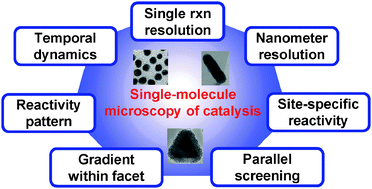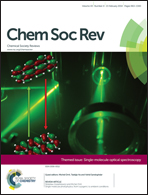Spatiotemporal catalytic dynamics within single nanocatalysts revealed by single-molecule microscopy
Abstract
This review discusses the latest advances in using single-molecule microscopy of fluorogenic reactions to examine and understand the spatiotemporal catalytic behaviors of single metal nanoparticles of various shapes including pseudospheres, nanorods, and nanoplates. Real-time single-turnover kinetics reveal size-, catalysis-, and metal-dependent temporal activity fluctuations of single pseudospherical nanoparticles (<20 nm in diameter). These temporal catalytic dynamics can be related to nanoparticles' dynamic surface restructuring whose timescales and energetics can be quantified. Single-molecule super-resolution catalysis imaging further enables the direct quantification of catalytic activities at different surface sites (i.e., ends vs. sides, or corner, edge vs. facet regions) on single pseudo 1-D and 2-D nanocrystals, and uncovers linear and radial activity gradients within the same surface facets. These spatial activity patterns within single nanocrystals can be attributed to the inhomogeneous distributions of low-coordination surface sites, including corner, edge, and defect sites, among which the distribution of defect sites is correlated with the nanocrystals' morphology and growth mechanisms. A brief discussion is given on the extension of the single-molecule imaging approach to catalysis that does not involve fluorescent molecules.

- This article is part of the themed collection: Single-molecule optical spectroscopy

 Please wait while we load your content...
Please wait while we load your content...